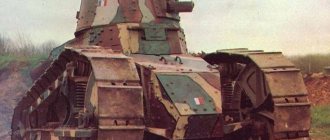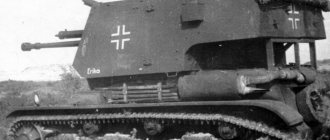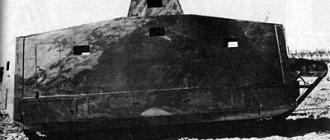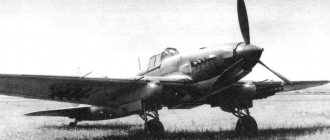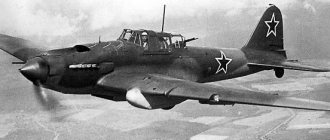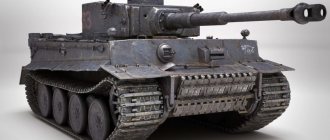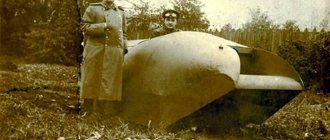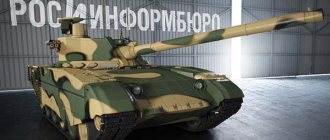FT-17. Reflections near a tank in a museum
Tanks and creativity.
I haven’t written anything about tanks for a long time, but here, one might say, the topic came to me on its own. At the Army Museum in Paris, on the ground floor, right at the entrance, one of the few surviving tanks of this type was discovered, and in good condition.
Tank "Renault FT-17" model 1918 with a cast turret in the Paris Army Museum
And then there’s a series of articles on VO about tanks from different wars and historical periods. And so I thought: why did the French make it like this? And how did the French, who made the worst tank of the First World War (you guessed it, of course, it was the Schneider SA.1), then manage to “correct” and make the best tank, the Renault FT, for real? a revolutionary combat vehicle at that time, which set the trend for almost all tanks of the future, even to this day and only with rare, very rare exceptions. That is, what will this again be a conversation about? About creativity, of course. That need is the best stimulator of the creative activity of the brain, and also that positive experience accumulates and sooner or later leads to a positive result.
"Schneider" CA.1 in the tank museum in Samur
This schematic drawing especially clearly shows that it would be possible to easily make the front armor plate of the hull on this tank without a characteristic break, and install not one gun on it, but two, just by slightly increasing the side sponsons! The ventilation grille at the front is also completely useless. It could well have been replaced by an armored damper with a gap directed towards the driver’s cabin
After all, our Renault arose out of the desire and need to give the then standard French tanks, such as the same Schneider CA 1, something like a “light partner” that would be more useful to them than heavy ones breakthrough tanks. And as a result, a joint and semi-private project was born, the father of French tanks, General Estienne, and the French industrialist Renault. After many bureaucratic delays, the first prototypes were tested at the beginning of 1917 and turned out to be very useful. Moreover, the new tank included many innovative solutions, including layout, design, and even a device for manual rotation of the turret.
This photo clearly shows the driver's viewing slot and the turret with the 37 mm Puteaux gun. Rivets of the so-called “armor-resistant form”
Let's look at Schneider again. Well, why, having before their eyes the English symmetrical tanks, did the French engineers for some reason decide that their tank should be asymmetrical? Well, why should they have made it wider, placed two sponsons on the sides and placed 75-mm infantry guns in them? Or did you want to save money on guns? The front armor plate could be made completely straight, that is, its ricochet properties could be increased, and the machine guns could remain located on the sides. Or put a cylindrical turret with a gun on it, keeping the machine guns on the sides. The dimensions and power of the motor made it possible to do all this. However, this was not done. Didn't think of it? No experience? But British tanks and armored cars with machine gun and even cannon turrets were before their eyes! Where were the military looking when they were handed such a... lopsided freak, why didn’t they turn back... In short, there are a lot of questions, but they all remain unanswered, although more than 100 years have passed.
Upper support roller suspension
But Louis Renault, although he was an automobile industrialist, first thought about the turret, the use of which made the use of tank weapons much more flexible and effective, and the turret tank itself turned out to be much more flexible and easier to control than its heavier partners, and because of this, even better protected. Although the short length of the vehicle, somewhat corrected by the addition of a special “tail,” made it difficult to cross a trench, the presence of a track with a large front wheel gave this tank good ability to overcome high obstacles. It turned out that its design was easily adaptable to numerous variants (in addition to the basic variants equipped with either one machine gun or one 37 mm cannon), signal tanks, command tanks (TSF), “gun tanks” with a 75 mm gun (according to essentially the same self-propelled gun), and even... a tank transporter of fascines for filling ditches!
Interestingly, the drive wheels on the Renault tanks were made of... wood and only covered with thin sheet metal. Well, the rim was metal. Cast wheels of this diameter made of cast iron would be too heavy and made of aluminum too expensive!
Both the French and Americans used the FT-17 during and after World War I, and when it ended, it was exported to more than ten countries, including Japan, Poland, Canada, Spain and Brazil. National copies of Renault were produced in Italy, the USA, Japan and the Soviet Union and were used in almost all armed conflicts of the twenties and thirties of the last century. In World War II it was also used by the French, Finns and Yugoslavs. Even the Germans themselves made extensive use of captured FT-17s.
The famous "tail". By the way, it is folding. And under it is another “twist” from the “starter”
FT-17s were first used in combat on May 31, 1918, to support a Moroccan infantry attack in the Retz forest in an attempt to stop the German spring offensive. Here is an excerpt from a report written by one of the participants in this operation, Captain Ober, from the 304th Tank Company: “We began moving on a signal and moved almost blindly through a corn field. After a few hundred yards the corn suddenly ran out and we found ourselves in open ground and immediately subjected to heavy machine gun fire, especially along the viewing slits and port openings. The impact of bullets on the armor, accompanied by a loud crack, showed us the general direction of the fire, the source of which was on the left. Many bullets hit the gun shield, and their fragments made working with it difficult. But we turned the turret and noticed a machine gun 50 meters away. It took five shots to finish him off, after which the shelling stopped. All the tanks acted together, they fired and maneuvered, which showed us that we were on the line of resistance with the enemy and all our vehicles entered the battle."
Of course, a lot of things in the new tank were not thought through. Thus, tank commanders had to give commands to their drivers by kicking them. This was the only "means" of internal communication, since the FT-17 did not have any kind of system such as a radio intercom, and the tanks themselves were too noisy for voice commands to be heard in them. To force the driver to move forward, the commander kicked him in the back. Similarly, a kick to one shoulder signaled the need to turn in the direction of the kick. The stop signal was a blow... to the driver's head, and repeated blows to the head meant that the driver had to turn back. It is clear, of course, that the tank commander did not hit his partner with all his might and that the driver’s back was covered by the seat back and his head was covered by a helmet. But in the heat of battle, you never know what could happen.
Renault tanks in a combat situation in the First World War
Controlling the tank was also difficult. Usually, when talking about tanks of the First World War, the authors of articles cite as an example the imperfect control of British tanks, and for some reason always only the MK.I tank. But the FT-17 tank was by no means an example of perfection in this regard. The driver's controls consisted of a clutch pedal located on the left side of the floor, an accelerator pedal in the center, and a parking brake pedal on the right. The engine was started using a handle located in the rear of the gunner's compartment on the armor wall separating it from the engine compartment. The driver could control the speed of the tank by pressing the accelerator pedal or using the manual throttle control, which was located on his right side. An ignition control lever was also provided, which allowed the driver to increase or decrease the current supply, depending on the load on the engine. Two large levers, one on each side of the driver's seat, operated the service brakes. To turn right, the driver had to press the right lever, braking the track on the right. At the same time, the left caterpillar continued to move at the same speed, which led to the tank turning. The turn to the left was carried out in a similar way and there seemed to be nothing complicated about it, because both tanks of the Second World War and modern cars were controlled in almost the same way. But only here it was necessary to constantly monitor the “spark” and try not to burn the clutch. And this was precisely the most difficult thing. If we take into account that the tank’s suspension was very imperfect, that it shook and tossed at the same time, then it becomes clear that driving a small Renault was even more difficult than a large English tank, where the commander, in addition, sat next to the driver and could tell him the way with gestures.
Renault in camouflage paint. By the way, on this tank the drive wheels of early production are spoked and cast!
The numerous attempts to come up with effective camouflage for the FT-17 were very interesting. Unfortunately, it was never possible to develop an officially recognized camouflage scheme, and FT tanks were supplied to the troops with both three- and four-color camouflage. The color palette used on the FT was similar to that previously used on the Schneider CA.1 and St Chamond tanks: blue-gray, dark green, brown and pale ochre. There were significant differences in the colors used, as was to be expected during the war.
Side view of a Renault machine gun
Well, now let's fantasize a little and imagine what the same Renault could look like if it were not for the haste and the general, higher technical literacy of the personnel of its designers. It is known, for example, that at first, according to the design, the tank was supposed to have a two-man turret, but for some reason things didn’t work out with it. It seems that the narrow body got in the way. But who prevented it from expanding it precisely in the area of the tower, well, let’s say, to the same width of the tracks? But this was not done and as a result the tank received a single-seat turret in two versions - cast (with thicker armor 22 mm thick) and faceted (with a thinner but durable thickness of 18 mm) from sheets of rolled armor, which literally “flowed around” with all sides of the “bashner” located in it. According to the project, the ventilation and at the same time inspection hood was supposed to be replaced with a “fungus”, but they did not do it, and the resulting design turned out to be even more convenient. And yet, instead of a single-man turret on a Renault tank, there could well have been a two-man turret, in which one turret would service the weapons, and the other would observe and command! Naturally, then we would have to think through the system of its communication with the driver. Well, let's say, on his dashboard, multi-colored lights could light up by turning a knob.
Side view of the cannon Renault
The tower itself could have been made with much simpler outlines. Well, let's say, in the shape of a horseshoe with an inclined rectangular front armor plate, in which, due to its size, it was not at all difficult to place both a cannon and a machine gun. The front armor plate of the hull could easily be made inclined without breaking, even leaving doors in it. The kink was needed for the convenience of placing inspection slits, but the slits themselves did not bring any joy to the tank crews, since... they received splashes from the lead of bullets breaking nearby. Because of this, 80% of tank crew injuries occurred, alas, in the eyes and... why not place just three infantry periscopes on the roof of the driver’s compartment directly in front of the turret for observation?!
But this is the Swedish “Stridsvagn fm28” - “Renault NC 27”. As you can see, it has the same hull, the same turret, but a much more advanced chassis, which, by the way, could have been invented in 1916! (Tank Museum or Arsenal in Strängnäs, Sweden)
Well, it would be quite possible to place a strobe device on the roof of the horseshoe tower - both for observation and for ventilation.
Renault NC 27 overcomes obstacle
The option of improving the Renault by installing rubber tracks on it and drum wheels located in front of them to increase cross-country ability did not justify itself. Although at first it was considered promising. But then it turned out that a torn rubber track cannot be repaired in a combat situation
The chassis of the tank looked quite satisfactory. He could cut down trees, tear down barbed wire, and cross ditches and trenches. But what he couldn’t do was... carry people on himself, except perhaps on the back of the “tail” and then only a maximum of two.
And the viewing slits remained slits as they were. (Tank Museum or Arsenal in Strängnäs, Sweden)
Meanwhile, it would be quite possible to take care of the infantry. To do this, it was only necessary to cover the caterpillar with an armored bulwark... in a stepped shape, with five seat steps above the upper branch of the caterpillar on each side! And so that they don’t fall off it, install folding handrails, similar to those made on seats for skiers on cable cars. Or put the same tracks as on the Renault NC1 tank, which appeared in the 20s and later even fought. On it, the bulwark could be quite simple, and making a folding handrail would also not be a particular problem. And how the infantry would have rejoiced at such an “invention,” needless to say.
"Renault NC 31" with bulwarks on tracks
But what was not done is not done at all. It’s a pity, it would be interesting to see how such tanks would operate, and what place they would have in the history of armored vehicles!
Yugoslav tanks of this type, destroyed in battles at the beginning of World War II
By the way, it’s interesting that for some reason they didn’t paint the tank in the Paris museum with camouflage. But to draw a tactical emblem - they did...
And one more interesting fact. The FT-17 had a competitor - a turretless tank with a short 75-mm cannon, that is, armed more powerfully and with thicker armor, but it never saw the light of day.
Experienced tank (drawing by A. Sheps)
Photo of a Peugeot during the war years
General diagram of the Peugeot tank
And finally, this: a self-propelled gun with a 75 mm gun on a Renault chassis. This also happened and even drove and shot...
Front view
Back view
And the question is: how do such structures arise in the first place? And the answer is out of necessity, and also, before harping on metal, you just had to sit down and think a little!
Equipment
Here is the vehicle's research tree. There is nothing wrong with these sums of experience and raising the car to top condition seems to be easy and quite fun. I won’t comment on which module to open first because even the cost of an error here tends to zero. However, let's take a more specific look at each module:
A fairly well-balanced top gun. Damage, penetration and rate of fire indicators are excellent. The accuracy and speed of information are also quite adequate. In general, it’s comfortable to play with him and you can drag out fights well...
The engine is of course rather weak, but for our mass it will add some dynamics, albeit a little. As for the chance of fire, there is a standard 20%. In principle, if they set us on fire, we will most likely burn and will not have time to use a fire extinguisher.
A top-end chassis will add turning speed and increase the resistance of various soils. There is probably nothing more to add.
A radio station at 300 m on level 2 is more than enough for us. Its installation is required, but at the lowest priority.
Operation and combat use[ | ]
Destroyed Polish FT
In 1919, in the Polish Army of General Haller in France, 1 tank regiment was formed, equipped with 120 FT tanks (fourth place in the world relative to the available armored forces). In June 1919, the tank regiment, together with General Haller's army, returned to Poland, with all the equipment; participated in the Soviet-Polish war.
In 1919, six tanks were captured by the Red Army near Odessa from the expeditionary force of the Entente countries. One tank was sent to Moscow and, by order of Lenin, at the Krasnoye Sormovo plant, the tank was carefully copied and produced with an AMO engine and Izhorsky armor, sometimes referred to as the first Soviet tank "". True, some parts were lost along the way, so some units, for example, the gearbox, had to be redesigned.
The task was completed, but only partially: only 15 copies were built, and, according to the conclusion of one of the commissions, they were “unsatisfactory in quality, inconvenient to wield weapons, and some were completely unarmed.”
The first tanks arrived in Japan shortly after the end of the First World War. The first Japanese tank was the British Mk.IV, which arrived in October 1918, followed in 1919 by approximately 6 Mk.A Whippets and 13 French FT[11], designated Ko Gata Sensha in Japan.[11]
In 1920, France had 9 three-battalion regiments[12].
FTs were actively used by Spain in Morocco during the Spanish-French-Moroccan War of 1921-1926. Several dozen FTs were purchased from France; the first batch of tanks arrived in the summer of 1922. 10 remained operational by the time of the Francoist rebellion in June 1936. Another 64 were purchased in Poland “for Uruguay” and delivered to Bilbao on November 8, 1936 - March 31, 1937 on three ships.[13]
Even in the late 1930s, the FT remained a combat-ready armored vehicle. As of August 15, 1939, Germany had 1,445 Pz.Kpfw.I Ausf.A
and
Ausf.B
[14], which accounted for 46.4% of all Panzerwaffe armored vehicles.
Therefore, even hopelessly outdated FTs by that time, which had cannon armament, had an advantage over it in battle and were quite suitable, under conditions of proper use, for use as a tank destroyer [ source not specified 3987 days
]. However, it should be taken into account that the German Pz.Kpfw.I, although still used by the Wehrmacht in significant quantities, had already ceded the role of the main tank to the much more combat-ready Pz.Kpfw.II, Pz.Kpfw.III and the Pz.Kpfw, which was still in small-scale production. IV.
By the beginning of World War II, the FT was in service in the armies of a number of countries, including France and Poland. The Polish army had 102 tanks of this type.
32 tanks were in service with Finland and took part in the Winter War.
After the surrender of France in the summer of 1940, French tanks were placed at the disposal of the German military command. Captured French tanks were used by the Wehrmacht as training vehicles, as well as for rear patrols and airfield protection. A small part of the tanks remained in the French colonies, which were subject to the pro-German Vichy regime. In particular, in Morocco, French FTs were in service with the 62nd and 66th tank battalions. In Algeria in the 64th tank battalion.
As of early April 1941, before the German invasion of Greece, 11 FT tanks remained in service with the Greek army[15].
Tanks were used during the Paris Uprising against the German occupiers in August 1944.[16] and in the clash between Chinese and Japanese forces at Hanoi Fortress in August 1945[17][18].
See also[ | ]
- M1917 (tank)
- Tank KS
- T-18 ( MS-1
) - Soviet light infantry tank of the 1920s. Created in 1925-1927 on the basis of the French FT tank and its Italian version, the Fiat 3000, and became the first Soviet-developed tank. It was mass-produced from 1928 to 1931; a total of 959 tanks of this type were produced in several versions, not counting the prototype. - Model 1902 76 mm divisional gun. In a number of cases, the gun was used as an anti-tank weapon. The White Guards and interventionists used a small number of tanks, mainly French Renault FT and British Mk V and Whippet. Divisional gun mod. 1902 with its high muzzle velocity (588 m/s) was a fairly effective weapon against their bulletproof armor. In 1920, during the Soviet-Polish War, these guns were used again in this capacity - against the Polish Renault FT.
This tank is also present in the games World of Tanks and World of Tanks Blitz.
Historical facts[ | ]
- The first tank unit on the territory of the former Russian Empire - a tank division under the Council of People's Commissars of Soviet Ukraine - was created in Kharkov by the painter Selyavkin in 1919 from captured Renault FT tanks captured near Odessa (Berezovka station). Subsequently, the first tank unit in the USSR was transformed into the Tank Squadron of the Red Army (the so-called “Lefortovo”) (1922), the main striking force of which were captured British Mark V tanks.
- Brest Fortress: September 14, 1939 77 tanks of the German 10th Panzer Division tried to take the city and the fortress in a raid, but were repulsed by Polish infantry with the support of 12 FT-17 tanks, which blocked the entrance gate to the fortress [ source not specified 1278 days
].
Used [ | ]
Armored division of the Red Army with a captured French FT tank captured near Odessa. Kharkov, April 1919
| The section lacks links to sources. Information must be verifiable or it may be deleted. You can edit the article to add links to authoritative sources. This mark was set on May 12, 2011 . |
- Afghanistan
- Belgium - 54 pcs.
- Brazil - 40 pcs.
- UK - licensed American
- German Empire - used as trophies
- Third Reich - used as trophies under the name Pz.Kpfw.17R 730(f) or Pz.Kpfw.18R 730(f) - about 500 pieces.
- Greece
- Iran
- Spain - in 1922, the first 12 units were delivered from France, in 1925 - 6 more units, a total of 90 units were received by the beginning of June 1936. (of which 10 or 12 remained combat-ready by the beginning of the civil war). After the start of the war, the Republicans got 6 FT in Madrid, the Francoists got 8 FT in Zaragoza[5]
- Italy - 7[6] units, then their own modification of the FIAT 3000 was produced
- Canada - licensed American
- China - one/two dozen
- Lithuania - 12 pcs. FT machine guns were received in 1923, they were re-equipped with a 7.92 mm MG.O8 machine gun; in 1940 they were transferred to the Red Army. As of June 22, 1941, the 202nd Motorized Division of the 12th Mechanized Corps of the Red Army included 6 faulty Lithuanian FTs[7]
- Netherlands - 2 pcs.
- Norway
- Poland - 174 pcs.
- Russia (white movement)
- Romania - 74 pcs.
- Soviet Union - captured white ones; then its own modification “Russian Renault” was produced
- USA - 514 units, then produced under license under the name M1917
- Türkiye
- Finland - 32 pcs.[8]
- France - 3737 tanks 1917-1940.
- Czechoslovakia - 7 pcs.
- Switzerland - 5 pcs.
- Sweden - modification NC27 (NC1) purchased for testing
- Estonia - 12 pcs.
- Yugoslavia - 48 units were purchased in the 1920s. FT, which remained in service until the German invasion of Yugoslavia in the spring of 1941[9]
- Empire of Japan - in 1922, a batch of FTs was purchased in France (which entered service under the name Type 79 “Ko-Gata”) [10], at the end of the 1930s, three more FT platoons (a tank company of the French army) were captured in China. , which were handed over to the Japanese occupation forces in China[7]
Content
- 1 History of creation and production
- 2 Design description 2.1 Armored hull and turret
- 2.2 Armament
- 2.3 Engine and transmission
- 2.4 Chassis
- 3.1 Foreign FT variants
Notes[ | ]
- M. Kolomiets, S. Fedoseev.
Light tank Renault FT-17. - Moscow: KM Strategy, 2004. - P. 13. - 79 p. — (Front-line illustration No. 1/2004). — 3000 copies. — ISBN 5-90126-601-3. - M. Kolomiets, S. Fedoseev.
Light tank Renault FT-17. - M.: KM Strategy, 2004. - P. 12. - 79 p. — (Front-line illustration No. 1/2004). — 3000 copies. — ISBN 5-90126-601-3. - M. Kolomiets, S. Fedoseev.
Light tank Renault FT. - Moscow: KM Strategy, 2004. - P. 12. - 79 p. — (Front-line illustration No. 1/2004). — 3000 copies. — ISBN 5-90126-601-3. - ↑ 1 2
Tank Renault FT-17 - Description page 2
(unspecified)
. pro-tank.ru. Access date: March 14, 2022. - S. L. Fedoseev. All tanks of the First World War. The most complete encyclopedia. M., “Yauza”, “EXMO”, 2013. pp. 384-386
- Filippo Cappellano, Pier Paolo Battistelli and Richard Chasemore.
Italian Light Tanks: 1919–45 / Filippo Cappellano. — Bloomsbury Publishing. - Bloomsbury Publishing, Jun 20, 2012. - P. 124. - 124 p. - ↑ 12
S. L. Fedoseev. All tanks of the First World War. The most complete encyclopedia. M., “Yauza”, “EXMO”, 2013. p. 382 - M. B. Baryatinsky. Light tanks of the Second World War. M., “Collection” - “Yauza”, 2007. p. 115
- S. L. Fedoseev. All tanks of the First World War. The most complete encyclopedia. M., “Yauza”, “EXMO”, 2013. p. 387
- S. L. Fedoseev. All tanks of the First World War. The most complete encyclopedia. M., “Yauza”, “EXMO”, 2013. p. 388
- ↑ 1 2 S. J. Zaloga.
Japanese Tanks 1939-45. - London: Osprey Publishing, 2007. - S. . — 48 s. — (New Vanguard #137). — ISBN 978-1-84603-091-8. - Tanks in the First World War (undefined)
.
btgv.ru.
_ Date accessed: February 11, 2022. - Supply of the Northern Front. Rozin Alexander. Soviet sailors in the Spanish Civil War in 1936-1939. Part 1
- T. L. Jentz.
Panzerkampfwagen I. Kl.Pz.Bef.Wg. to VK 18.01. - Boyds, MD: Panzer Tracts, 2002. - P. 179. - (Panzer Tracts No. 1-2). — ISBN 0-97084-078-0. - Museum of military glory in Yambol or “four” and “stuga” in Bulgaria // “Technology and weapons”, No. 4, 2014. pp. 41-47
- Gander T.J. Tanks of the Second World War/Trans. from English S. Fedoseeva. — M.: LLC “AST Publishing House”; LLC Publishing House Astrel, 2001. - P. 43)
- Kolomiets M., Fedoseev S. Tank No. 1 Renault FT. The first one is legendary. - M: Yauza, 2010. - P. 90).
- (see 10 famous tanks // Military history. 2015, No. 3, p. 29
- “The WWI tank that helped change warfare forever”, BBC, 31 May 2018
